Blindsided on the Road to Nowhere
April 25, 2011 § 2 Comments
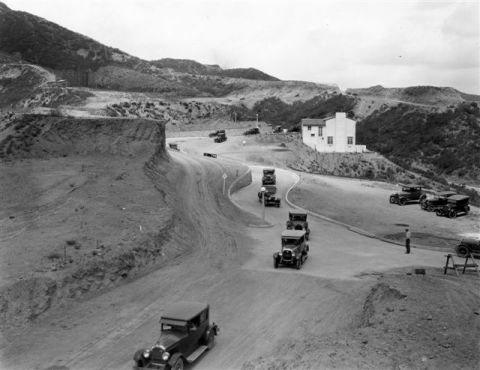
Mulholland Highway Under Construction, 1925. (The blind curves lie ahead of the car in foreground)/Los Angeles Public Library, Security Pacific Collection
Mulholland Highway curves around the western edge of Beachwood Canyon like a massive snake. A man-made thoroughfare butressed by granite retaining walls, the Highway (not to be confused with Mulholland Drive) was built, like all the roads in Hollywoodland, in the mid-1920s. It contains both a split-level section (under construction in the photo above) and a cliff-side stretch locals call the blind curves.
As Gregory Williams points out in his book, The Story of Hollywood (BL Press, 2005), “old-timers called Mulholland Highway ‘the road to nowhere,'” an accurate title for a street that didn’t connect to anything until Canyon Lake Drive was built in the early 1960s.
What was intended as a glorified driveway to the Canyon’s uppermost houses is now a heavily-traveled route for tourists seeking a view of the Hollywood Sign, commuters to and from Burbank and people who use Lake Hollywood Park. The blind curves are made more hazardous by people who park their cars to take pictures of the Hollywood Sign. As if that weren’t enough, the road has no median line, making it easier for nervous drivers to justifying driving in the middle. That’s what happened yesterday when a truck came barreling towards me around one of the curves as I headed home from the park. In swerving to avoid being hit, I sheared off my passenger’s side window against one of the many trash cans that are perpetually out by the curb.
 The amazing thing is that it’s never happened to me before on that stretch of Mulholland Highway, during an estimated 1300 round trips over the past 5 years. In light of that record I should be glad, but the cost of the repair* on my mirror leaves me less than grateful.
The amazing thing is that it’s never happened to me before on that stretch of Mulholland Highway, during an estimated 1300 round trips over the past 5 years. In light of that record I should be glad, but the cost of the repair* on my mirror leaves me less than grateful.
*$320!
WSJ Does Hollywoodland
April 20, 2011 § Leave a comment
Hollywoodland’s tourist gridlock hit the national media today, via Tamara Audi’s fair-minded assessment of the situation in the Wall Street Journal. Here’s a link; the video’s not bad, either:
On the downside, Under the Hollywood Sign’s mother is worried about Hollywoodland property values and will require a reassuring phone call. For her part, UTHS plans to remain in the Canyon as long as she can scrape up the mortgage payments. Where else can she be ten minutes away from some serious nightlife, yet fall asleep to the hooting of owls and the croaking of frogs?
Nowhere else but Hollywoodland.
Bronze Plaques Stolen off the Hollywoodland Gates
April 19, 2011 § 7 Comments
Christine O’Brien has alerted me to the fact that the bronze plaques on the historic Hollywoodland gates have been stolen. They measure approximately 24” x 18” and read HOLLYWOODLAND est.1923 Anyone knowing their whereabouts should contact: info@ Hollywoodland.org
Albert Kothe: A German Immigrant’s Life in Hollywoodland, Part II
April 18, 2011 § 2 Comments
Albert Kothe no doubt left Hamburg for economic reasons, as jobs were in short supply in Germany’s ruined post-WWI economy. He seems to have earned his passage to America as a merchant marine, judging from a shipboard photo. How Kothe wound up in Los Angeles is unclear, but he quickly made it his home: among the artifacts found after his death was this certificate for a citizenship course, dated 1933.
His photos tell the story of a bachelor existence enlivened by female friends, letters and postcards from home, his dogs and–most of all–cars. Kothe seems especially proud of this car, judging from the number of photos in which he appears beside it.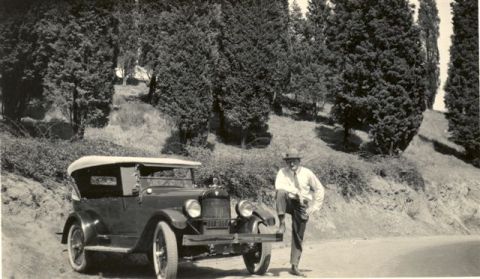
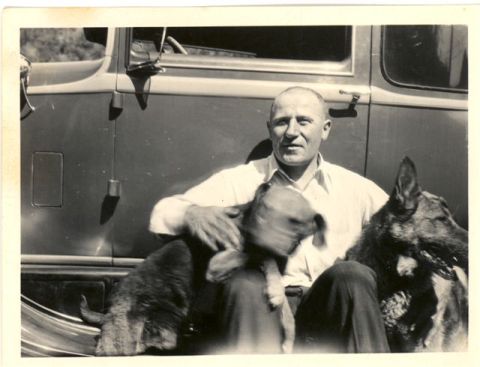 Because he didn’t own a home, first renting the cabin at 3200 N. Beachwood Drive and later an apartment behind the Beachwood Market, Kothe’s car ownership symbolized the American Dream. In the 1940’s, Kothe earned local notoriety when, during an inebriated visit to his old workplace, his car spun out of control and knocked down the letter “H” of the Hollywoodland Sign. (The righted and repaired letter– already infamous as Peg Entwistle’s jumping-off point–somehow survived until 1978, when the old Sign was torn down and the current version built.)
Because he didn’t own a home, first renting the cabin at 3200 N. Beachwood Drive and later an apartment behind the Beachwood Market, Kothe’s car ownership symbolized the American Dream. In the 1940’s, Kothe earned local notoriety when, during an inebriated visit to his old workplace, his car spun out of control and knocked down the letter “H” of the Hollywoodland Sign. (The righted and repaired letter– already infamous as Peg Entwistle’s jumping-off point–somehow survived until 1978, when the old Sign was torn down and the current version built.)
Ironically, in light of his penchant for drinking and driving, Kothe went on to drive the Hollywoodland jitney, a job he apparently relished. The last incarnation of Hollywoodland’s neighborhood bus, Kothe’s woody wagon carried residents from the bus stop in Beachwood Village to their hillside homes. Service ended sometime in the 1950s, probably because most families had two cars by then.
 In the early 1960s Kothe moved from his cabin to Beachwood Village, where he lived in an apartment owned by the Williams family. A neighborhood fixture, he enjoyed a certain fame, both local and national, for having changed the lightbulbs on the Hollywood Sign. He died in 1974, at the age of 81, having lived in the Sign’s shadow for more than half a century.
In the early 1960s Kothe moved from his cabin to Beachwood Village, where he lived in an apartment owned by the Williams family. A neighborhood fixture, he enjoyed a certain fame, both local and national, for having changed the lightbulbs on the Hollywood Sign. He died in 1974, at the age of 81, having lived in the Sign’s shadow for more than half a century.
Schadenfreude, Tour Bus Edition
April 17, 2011 § 1 Comment
Coming down Beachwood Drive just before 1pm today, I was amazed by the sight of a motorcycle patrolman ticketing the Starlines Tour trolley bus. Yes, the red-and-green bus that comes up to Hollywoodland several times a day was busted. What for? It might have been for running the stop sign at Scenic, but I’d guess it was for illegal stopping.
Normally this sort of lawlessness–tour bus drivers slamming on the brakes every so often, forcing all traffic behind them to stop–goes unpunished. The drivers take it as their right to stop wherever and whenever they want, regardless of the fact that Beachwood Drive is a two-lane road where passing is mostly prohibited. They do it with impunity: the one time I confronted a tour van driver (from a rival company) who’d impeded my progress for the past mile, he refused to look at me, let alone respond. It was as if my demand that he pull over to give his spiel were unreasonable, if not crazy. Clearly, the idea that people actually live near the Hollywood Sign came as a shock to both him and his passengers, who stared silently into middle distance as I complained.
So I couldn’t help but smile when I saw the Starlines trolley ticketed. Little did I know that a half an hour later, on my return trip, I would be further rewarded by the same officer, now ticketing a Hollywood Tours van in exactly the same place, just north of Scenic. Could this be the start of a crackdown? Please say yes, LAPD! And thank you for making my day.
Albert Kothe: A German Immigrant’s Life in Hollywoodland, Part I
April 13, 2011 § 2 Comments

Straight Outta Hamburg/All Photos Albert Kothe Family Archive, courtesy Harry Williams, unless otherwise noted
Albert Hendrick Kothe was born in Hamburg, Germany in 1893. After World War I, he made his way to America and settled in Los Angeles, where he found work and a new home in Hollywoodland. Like so many Canyon residents, Kothe lived out his life here, in the process becoming a neighborhood fixture, a Zelig-like figure–and something of a local legend.
Albert Kothe may or may not have helped to build the Hollywoodland Sign, but he certainly was its caretaker upon its completion in July, 1923. His job, which probably lasted until 1939, was to change the 4,000 lightbulbs that lit the Sign at night, a Sisyphusian task for which ladders were kept permanently propped against the Sign’s back. Though Kothe undoubtably spent a great many daylight hours on Mt. Lee, he didn’t actually live there. (The myth that Kothe “lived in a shack behind the first L” is so pervasive that Leo Braudy repeats it in his new book The Hollywood Sign [Yale University Press, 2011] Oops.) Although there was a shed behind the Sign, it housed lightbulbs and other equipment, while Kothe resided in a cabin at the north end of Beachwood Drive. (The cabin was probably built for the foreman of the stonemasons who built the Hollywoodland walls and stairs from 1923-25. The stonemasons lived in adjacent tents.) The cabin, which was torn down for houses 50 years ago, looked like this:
When the Hollywoodland Realty Company stopped maintaining the Sign in 1939, Kothe found work at Wolf’s Lair, a house large enough to require a full-time handyman. Kothe’s employment by Bud Wolf has satisfying parallels in literature and movies, for the two men at first glance were polar opposites: Wolf a rich, companionable bon vivant; Kothe a poor laborer and lifelong bachelor. But in truth, they were flip sides of the same coin–uncompromising, somewhat eccentric men who discovered their niche in Hollywoodland, and stayed.
Next time: Kothe’s latter years–and automotive adventures.
Preston Sturges and Harold Lloyd: A Tale of Two Houses
April 6, 2011 § Leave a comment
In 2009, I wrote about my search for Preston Sturges’s Hollywood house, which I assumed had been torn down in the late 1940s to make room for the 101 Freeway. After reading in Sturges’s memoir that, in lieu of demolition, he had the house cut in 3 pieces and moved to Vista Street, I immediately drove over, found the only house that matched its description, and took this photo:
I hadn’t been back until last week, after Steve Pond of The Wrap contacted me to ask if he could use my “before” photo in an article about the house, which in the interim had been bought and renovated by the actors/contractors Jeremy Renner and Kristoffer Winters. http://www.thewrap.com/movies/column-post/jeremy-renner-his-house-flipping-sideline-it-keeps-me-grounded-25878?page=0,0 I agreed, he linked my piece about the house, and I enjoyed a brief spike in traffic to this site. When I went by to take the “after” picture, I was impressed by the house’s handsome exterior. No longer clad in tired-looking white shingles, it boasts new clapboard, windows and metalwork, and a much nicer color scheme. It probably looks better now than when Sturges lived there, though without period photos there’s no way to be sure.
According to Pond’s article, this is the latest in a long line of houses that Renner and Winters have bought and rehabilitated, but it will be the last for a while, given Renner’s acting commitments.
Meanwhile, over in Windsor Square, the house once lived in by Sturges’s friend Harold Lloyd looks as horrible as it did when I wrote about it in June, 2009. https://underthehollywoodsign.wordpress.com/2009/06/05/harold-lloyd-lived-here/ But I’m hoping that when the second-generation owners finally decide to sell, Renner and Winters will have time to work their magic on it.
The Krotona Colony’s First Session: A Photographic Discovery
April 4, 2011 § Leave a comment
The photograph above depicts the opening assembly of the Krotona Colony in 1912. It appears in Joseph Ross’s Krotona of Old Hollywood, Vol. I (Montecito: El Montecito Oaks Press, 1989) as well as in my documentary, “Under the Hollywood Sign,” and seems to represent the ideals and aspirations of Beachwood’s new utopia. A heavily female, racially integrated group sits politely in the Colony’s amphitheater, facing the stage–but who was on it?
The answer was a mystery until I came across this photo in the Augustus Knudsen Archive of the Kauai Museum and recognized it as a photo from the same event. According to the notation on back, Knudsen (at the tree stump podium) was the first speaker.
Thanks to Eric James for the cleanup on the first photo.
Here’s a link to a new book on Krotona by Joseph Ross: http://www.amazon.com/Krotona-Theosophy-Krishnamurti-Theosophical-California/dp/0925943150/
____________________
For more about the Krotona Colony, purchase the documentary “Under the Hollywood Sign” at http://hopeandersonproductions.com/?page_id=3361
The film is also available for rent at https://vimeo.com/ondemand/uths


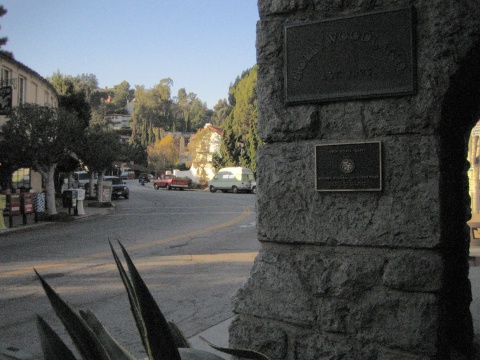
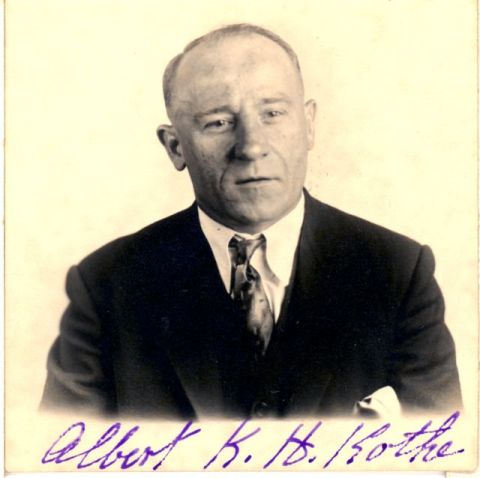


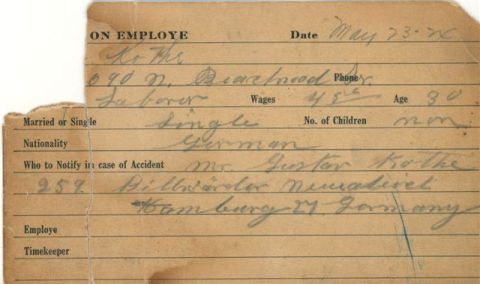
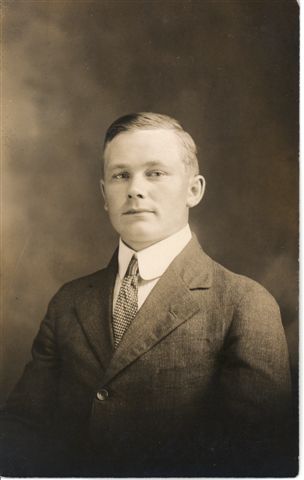
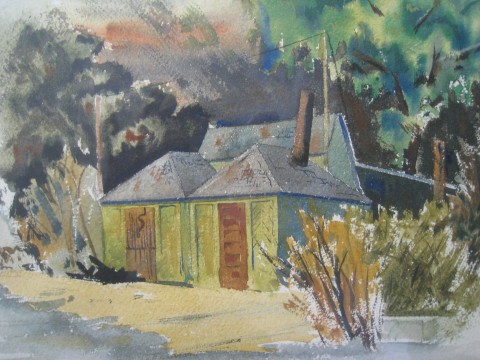
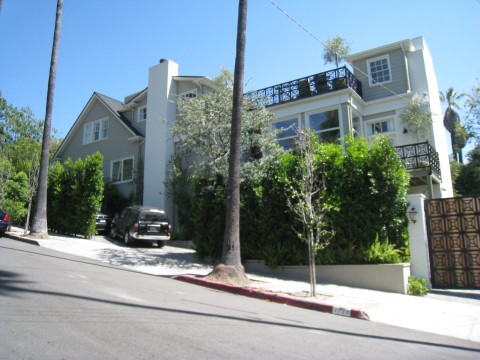




You must be logged in to post a comment.